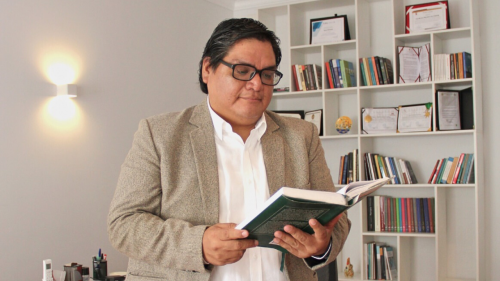How to design a virtual training course that works in your context – experiences from Peru

In early April, more than 770 public officials across Peru took our latest virtual training course on public financial management (PFM). This free seven-week course is part of a programme financed by the Swiss State Secretariat for Economic Affairs (SECO) to strengthen standards of PFM in 11 subnational governments. In all senses, it has been a huge success.
Some people have been surprised at this, given the disruption caused by the pandemic and the technical issues of computer and internet availability in Peru. My colleagues Carlos Vargas (Director of the PFM programme), Romina Cruz (Communications Officer) and I (Component Leader for Sustainability) take this opportunity to explain how, why and for whom we developed this course and how we managed to maintain such high levels of engagement. We hope our experiences are useful for others developing virtual training courses.
Multi-platform for maximum flexibility
The course is seriously "multi-platform": as well as a course web page, we have content on YouTube, Google Drive, Google Classroom, Vimeo, Facebook and Padlet. We have 23 regional WhatsApp discussion groups and a Telegram channel.
Why so many different platforms? For two reasons:
- To guarantee availability and access to all learners
- To minimise internet usage and costs
Delivering an online course on a single learning management system has advantages, but it isn’t practical in places with weak, unreliable or expensive internet services, like in many Peruvian provinces.
Our students – public officials in subnational governments – tell us that they like the flexibility of multiple platforms. It helps them to reduce their internet costs. For example, they can take advantage of mobile internet deals like free use of WhatsApp or Facebook’s pilot “Discover” app, which provides users with 10 MB of data every day.
The strict coronavirus lockdown in Peru has made this flexible multi-platform approach even more valuable. Most public officials are working from home and have to share their computer (if they have one) and internet connection with their partners and children attending school online. In addition, the government wishes to reserve internet capacity for essential services, particularly during the day.
In a survey we ran, most officials said they had use of a computer, but a large proportion also access the course on mobile phones and tablets. Flexibility and responsive web platforms are key.
“Social” media for professional purposes
People often ask why we use personal social media platforms like Facebook and WhatsApp for professional course content and communication.
Again, it is because it works in our context. We know from experience that Facebook and WhatsApp are good ways to communicate with our students – and more importantly to allow them to communicate with each other. For example, we have 7,230 followers on Facebook, all highly specialised and engaged. Just in the last week, we had more than 5,000 interactions with our posts. When they share our posts with their own networks, it amplifies our reach.
These channels have been hugely important in creating and sustaining our Public Finance Management Experts Network, for example. This is an initiative of graduates of the diploma programme that we ran in conjunction with Universidad ESAN. Thanks in large part to social media, this new network already has more than 200 members across six regions. It proves the power of using "social" media for professional purposes.
We've had a similarly positive experience using social media for training purposes.
Support networks and sustainability
Our use of social media has another big benefit: sustainability. Sustainable capacity building is not just about teaching new skills to individuals. The support networks that students create with each other help to increase their collective knowledge and sustain it over long periods.
In a university or classroom, students naturally get together and become friends. We are using social media to recreate these same support networks in the virtual space – and in fact to expand their potential. We see students helping each other with questions and ideas from across the country, at all times of day and night.
WhatsApp groups can include up to 250 people, so they work well for connecting people within cities or regions. With Telegram you can have 200,000 people in a group, so this is a good choice for cross-regional communication.
Creating a critical mass for real culture change
Linking people to people in this way is visibly helping to change the culture in Peru. Thanks to our onsite and virtual training courses over the last four years – and thanks to the support networks that have grown up – we are creating a critical mass of people in Peru who understand the importance and the details of strong and transparent public financial management.
Many of the new employees we have hired recently to support our wider programme have completed our training courses. Some are part of the Experts Network. This critical mass has three effects.
- Mitigating issues of staff rotation and skills gaps in subnational governments. Proper public financial management is part of the culture and processes of a government department, not just dependent on individuals.
- Real impact at the national level. Many of the officials we train go on to obtain jobs in the central government. They take their skills, attitudes and support networks with them.
- International cross-fertilisation. Students from other Latin American countries have enrolled on this course, although it focuses on Peruvian law. Why? Because, they tell us, they wish to be at the forefront when their countries adopt similar laws. Some are even using their new knowledge of Peruvian policies on public financial management to help advocate for improvements in their own countries’ laws.
Interaction, feedback and mutual support
With 770+ students signing up for this course, and limited in-house resources, we knew we couldn’t provide individual support to every single student.
Our system is simple. Students can send queries by email and we share the answers with everyone. They can also use a chat room on Facebook or request help in their WhatsApp groups. The students have been amazing. They immediately started thoughtfully answering each other’s questions and sharing ideas. And in the process of supporting others, they acknowledge that they learn better themselves.
It helps that some students (as well as ourselves, the course leaders) are or have been academics in universities. But access to information via the internet is the really critical factor that has transformed the learning process. In the past, teachers used to think they were the source of all knowledge, pouring it down onto students from the top during lectures. Now, many students know – or can find out – more than their teachers about specific topics and share it directly with their peers. Teachers need to understand that they are facilitators and supporters of learning. That is how we see ourselves.
We are also keen to get feedback ourselves in order to continuously improve the course. We send out surveys after each module asking for feedback and we also hold an optional Zoom call in the evening after each exam to discuss the questions. The feedback has been both encouraging and valuable.
Reflection, not just rote learning
In response to feedback, we recorded two extra videos applying the theory that the students are learning to the very real situation of covid-19 and its impact on public financial management. These kinds of “extras” are what students tell us they really value, as they encourage reflection and not just rote learning.
“Reflection” is the key word in our approach to testing as well. After each module, there is a test. The purpose is not to check whether students can regurgitate what they learned last week word for word. The aim is to encourage students to reflect on what they have learned and apply it to real situations.
This helps move the knowledge from short-term memory to long-term understanding. The testing is part of the learning process.
“Using the fruit to make marmalade for everyone”
Virtual training has clear benefits in normal times, not just during a pandemic. Our programme directly supports 11 subnational governments, but with virtual training we can reach the whole of Peru at no extra cost.
For example, our virtual course in open government in 2019 reached more than 3,350 officials and citizens across Peru. This wider diffusion of knowledge is important for long-term sustainability and culture change.
Getting the widest benefit for the lowest cost is vital in our country. That is another reason for our use of social media and networks of engaged individuals: it’s free. Saving on marketing costs means we can put more funds into the course development and support for students.
Three tips for designing virtual courses
Here are three important things we recommend to consider when developing virtual courses.
- Understand your students and adapt to their needs. Speak to them and listen carefully to what they want and need. Tailor your content appropriately and be prepared to adapt quickly in response to feedback.
- It’s not about the tool, but what you do with it. Choose your technologies to meet the needs of the students, not just yours – and be open to non-traditional platforms like social media if that will work best in your context.
- Learning is about the heart, not just the head. The personal touch is still important, even if the course is virtual. The chance to interact with others through chat rooms and social media is hugely valuable. It is what turns a one-off training course for individuals into a sustainable, knowledgeable and engaged network that can really achieve change.



